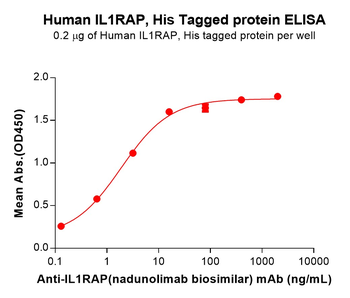You have no items in your shopping cart.
Cart summary

GPC1 Protein, Human, Recombinant (His)
Catalog Number: orb1961916
| Catalog Number | orb1961916 |
|---|---|
| Category | Proteins |
| Description | The Glypicans are a small multigene family of GPI-linked proteoglycans that play a key role in growth factor signaling. Human Glypican 1 (GPC1) is synthesized as a 558 amino acid (aa) preproprecursor that contains a 23 aa signal sequence, a 507 aa mature segment, and a 28 aa C-terminal prosegment. There are two potential N-linked and four potential O-linked sites for glycosylation or glycanation. There are potentially two heparan sulfate (HS) modifications on GPC1 that could contribute to a native molecular weight of approximately 200 kDa. Mature human GPC1 shares 91% aa identity with mature mouse GPC1. Cells known to express GPC1 include neurons, smooth and skeletal muscle cells, keratinocytes, osteoblasts, Schwann cells, immature dendritic cells, and tumor, plus tumorassociated vascular endothelial cells. The function of GPC1 is complex and varied. As a proteoglycan, it appears to make use of its HS adduct to impact select growth factor activity. This is accomplished by having juxtramembrane HS attachment sites, and a flexible, GPI-linkage. |
| Tag | N-6xHis |
| Purity | 98.00% |
| MW | 65-70 KDa (reducing condition) |
| UniProt ID | P35052 |
| Protein Sequence | Asp24-Thr529 |
| Expression System | HEK293 Cells |
| Biological Origin | Human |
| Biological Activity | The Glypicans are a small multigene family of GPI-linked proteoglycans that play a key role in growth factor signaling. Human Glypican 1 (GPC1) is synthesized as a 558 amino acid (aa) preproprecursor that contains a 23 aa signal sequence, a 507 aa mature segment, and a 28 aa C-terminal prosegment. There are two potential N-linked and four potential O-linked sites for glycosylation or glycanation. There are potentially two heparan sulfate (HS) modifications on GPC1 that could contribute to a native molecular weight of approximately 200 kDa. Mature human GPC1 shares 91% aa identity with mature mouse GPC1. Cells known to express GPC1 include neurons, smooth and skeletal muscle cells, keratinocytes, osteoblasts, Schwann cells, immature dendritic cells, and tumor, plus tumorassociated vascular endothelial cells. The function of GPC1 is complex and varied. As a proteoglycan, it appears to make use of its HS adduct to impact select growth factor activity. This is accomplished by having juxtramembrane HS attachment sites, and a flexible, GPI-linkage. |
| Expression Region | Asp24-Thr529 |
| Storage | -20°C |
| Note | For research use only |
| Application notes | Reconstitute the lyophilized protein in distilled water. The product concentration should not be less than 100 μg/ml. Before opening, centrifuge the tube to collect powder at the bottom. After adding the reconstitution buffer, avoid vortexing or pipetting for mixing. |
| Expiration Date | 6 months from date of receipt. |
Human GPC1 Protein, His Tag [orb1173721]
The purity of the protein is greater than 85% as determined by SDS-PAGE and Coomassie blue staining.
The protein has a predicted molecular mass of 57.0 kDa after removal of the signal peptide. The apparent molecular mass of GPC1-His is approximately 55-70 kDa due to glycosylation.
Mammalian
10 μg, 100 μg, 50 μgGlypican 1/GPC1 Protein, Human, Recombinant (GST & His & Myc) [orb1978508]
98.00%
55.7 kDa (predicted)
1 mg, 100 μg, 20 μgCeruloplasmin Protein, Human, Recombinant (His & Myc) [orb1978834]
98.00%
35.4 kDa (predicted)
1 mg, 100 μg, 20 μgGlypican 5 Protein, Human, Recombinant (His) [orb1958228]
98.00%
60.5 kDa (predicted); 60.5 kDa (reducing conditions)
100 μg




